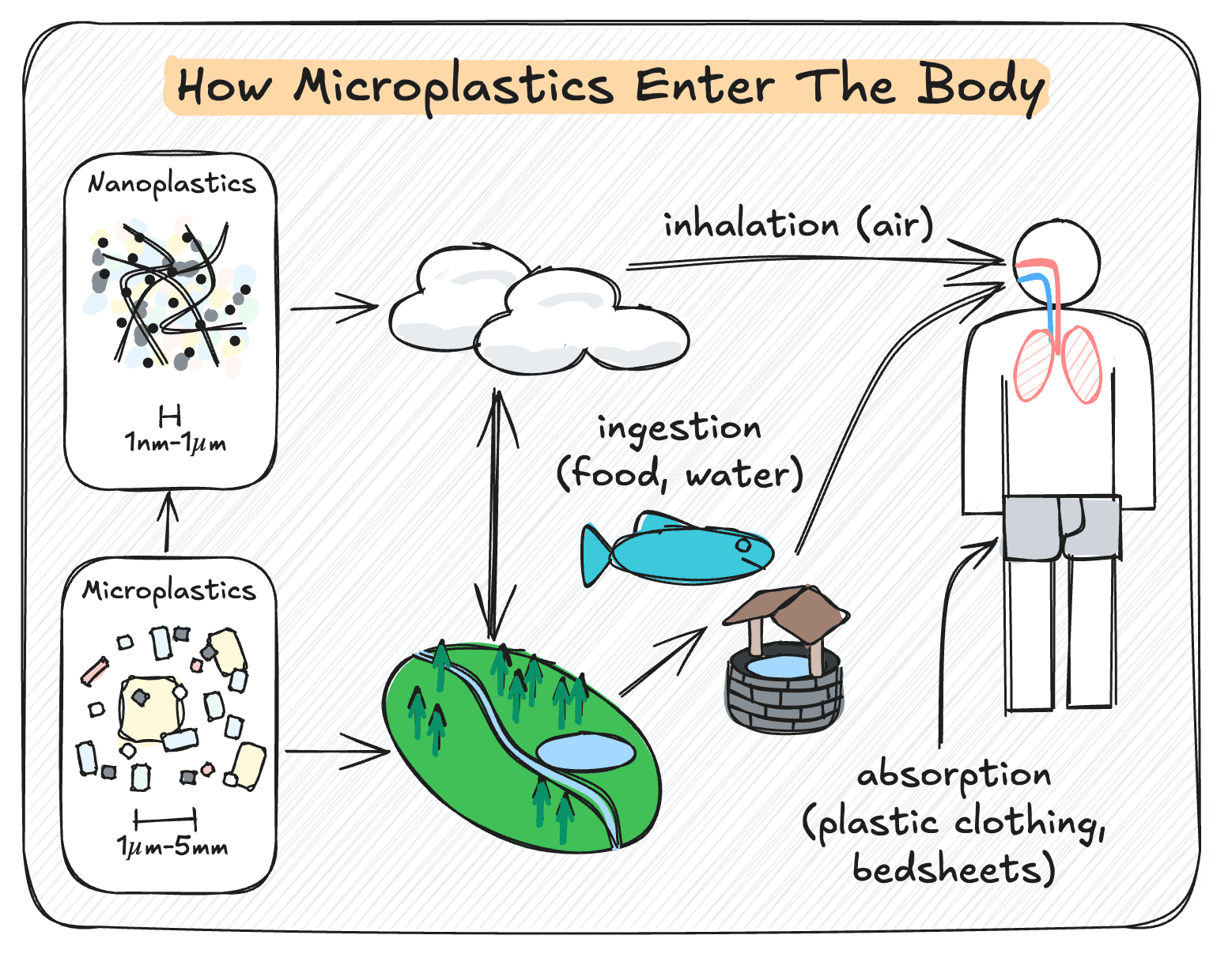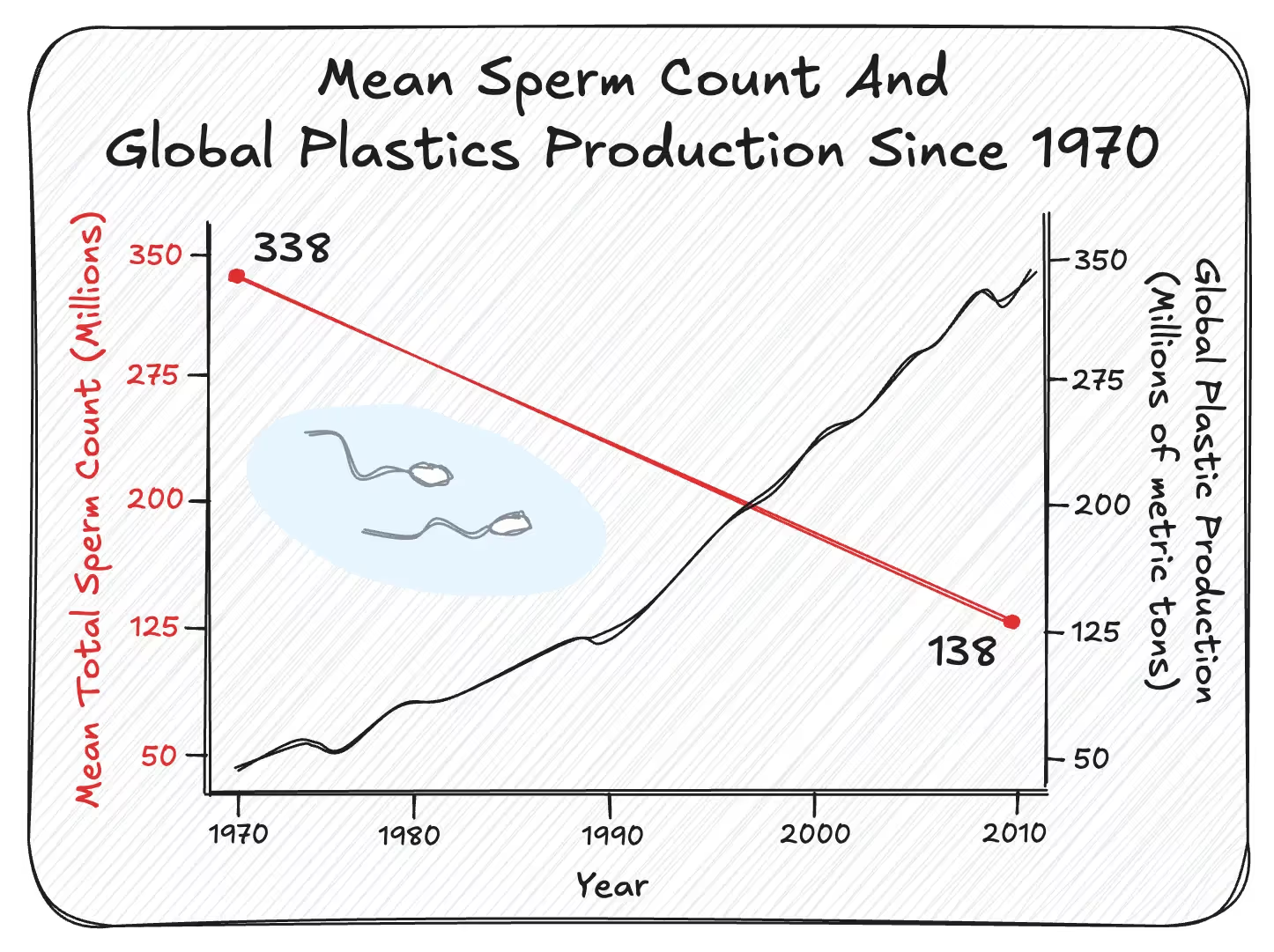What are microplastics?
Microplastics are defined as small particles less than 5mm in size that can originate from any plastic items, such as plastic water bottles, pipes, machinery, car tires, clothing, toys, and more.

Through mechanical wear, chemical interactions, or exposure to heat and sunlight, plastics will disintegrate into smaller and smaller pieces (even as small as 1 nanometers, referred to as ‘nanoplastics’).

How do microplastics get into the body?
As plastics break down (never fully biodegradable, if at all), they become small enough to ingest, inhale, and absorb through our skin, eventually getting into our cells and interfering with their functions.

Microplastics are most common in the water that we drink, regardless of the source. A 2019 paper using 50 different preceding studies on microplastic pollution in river and lake water, groundwater, tap water, and bottled drinking water showed that all sources had contained microplastics, with <a href="" id="">bottled water</a> being the worst offender.
Similarly, we ingest microplastics that are present in our food upon preparation, either from plastic in a farm animals' diet or from a the food manufacturing process. Microplastics are constantly shed from plastic tubes and surfaces in factories, and continue to do so through the form of plastic wrapping or packaging until the food is bought at a store. Additionally, non-stick pans and plastic kitchenware can further expose your foods with even more microplastics.
When microplastics get to the size for 'nanoplastic' classification, they can be inhaled in the air - especially in a dusty house or right outside a busy highway (tire wear being responsible for a significant portion of particulate matter globally).
Finally, clothing and bedding made from synthetic fabrics, which are plastic, can rub off onto your skin while you walk around or sleep, and become even more potent to absorb when in contact with sweat.
Types of plastic.
Plastic itself is defined as a synthetic or semi-synthetic material consisting of polymers. These polymers give plastic their lightweight, durable properties and can even be flexible with various production techniques.
Types of plastic include:
- “1” - Polyethylene terephthalate (PET) - water bottles, dispensing containers
- “2” - High-density polyethylene (HDPE) - shampoo bottles, milk bottles, freezer bags
- “3” - Low-density polyethylene (LDPE) - bags, containers, food packaging film
- “4” - Polypropylene (PP) - reusable plastic bottles, potato chip bags, microwave dishes, bottle caps, masks
- “5” - Polystyrene (PS) - cutlery, plates, cups
- “6” - Expanded polystyrene (EPS) - protective packaging, hot drink cups
- “7” - Other plastics
These types of plastics are organized by their Resin Identification Code (RIC), numbered 1-7, with the 7th group being a catch-all for less common combinations of plastic polymers.
Types 1, 2, 4, 5, and 6 generally do not contain BPA (bisphenol a), a widespread banned plastic for food and drink-grade use-cases due to research concluding that BPA was correlated to infertility, cancer, and behavioral effects.

Related Article
There are also other classes of technically-defined plastics that are more durable and heat resistant than others, such as silicone, but still can degrade and shed microplastic into our food, water, and air through mechanical abrasion or chemical interactions with surrounding materials.
Related Article
At the end of the day, more research is being done each year solidifying our theories that all plastic can and will leach microplastics over time. However, given the trajectory of experimentation and testing conclusions, it can be extrapolated that there are no plastic polymers that truly do not break off bits and pieces of microplastics into the environment that surrounds them.
The dangers of microplastics in humans are becoming more apparent along with our increased production and exposure to plastic products in everyday life.
Microplastic effects on hormones and fertility.
The first major concern for microplastics in our bodies is their effect on our hormones.
Structurally, the chemical compounds of these microplastics can imitate hormones, disrupting our endocrine system’s ability to properly produce hormones at a natural rate. This can wreak havoc on our development, metabolism, appetite, mood, and even our reproductive systems.

These endocrine disruptive chemicals are linked to a decrease in sperm quality and motility, meaning that consuming plastic directly negatively affects reproduction, and subsequently, taking steps to avoid microplastics could help remedy this adverse effect. Since widespread manufacturing of plastic products, sperm count has decreased worldwide by over 50%.

Avoiding microplastics are just as important for women, especially if they plan on becoming pregnant or are currently expecting, as these particles have been identified in human placentas during pregnancy and correlate to developmental toxicity and long-term effects for offspring.
Effects on the respiratory system.
Indifferent to other small particles of dust and chemicals entering our respiratory system, microplastics can be breathed in and build up in our lungs and airways that induce oxidative stress when inhaled. Some effects include coughing, sneezing, and shortness of breath due to inflammation damage.
Related Article
Gastrointestinal effects.
These microplastic particles, when ingested, are also proven to be linked to various gastrointestinal symptoms from changes in intestinal microbiomes, leading to bacteria imbalances and inflammation.
Furthermore, these microplastics induce chemical toxicity involving the absorption and accumulation of environmental toxins such as heavy metals, increasing their negative effects on the human body.
Microplastic neurotoxicity in the brain.
The buildup of microplastics within the central nervous system of brains of mice has been studied and the findings concluded measurable cognitive decline and dysfunction in tested populations.
Effects of these particles on human populations is currently a poorly researched field, however, we can infer similar effects on humans given the similarities in core brain function and processes between mammals.
Prolonged exposure of microplastics.
As plastic production continues to ramp up across the world since their industrialization in the 20th century, we can only assume that microplastic density in our air, water, and food sources are increasing year after year. As a result, we can expect to see more negative side effects take root with incoming generations of children born from parents who have been already consuming microplastics their entire lives, and will continue to become more prominent as this cycle continues.
How can I reduce my microplastic consumption?
If microplastics are everywhere, reducing exposure might seem futile at first. However, there is still plenty you can do at home with steps you can take to reduce the inhalation, ingestion, and absorption of microplastics.
Learn more about how to properly reduce microplastics in water, microplastics in food, microplastics in air and more in our Going Microplastic-Free Guide.
Related Article
Related

CLEANR: Filtering microplastics from your washing machine
Find out how you can reduce your microplastic footprint with CLEANR's new washing machine filters.

Is silicone plastic, and is it safe?
Is silicone safe, or is silicone toxic? Specifically, is silicone food safe, such as for silicone utensils, baby bottles, and more? See what you can replace silicone products with.

Microfibers: bad for the environment, and worse for you
The soft and popular fabric, microfiber, is made from plastic is a top contributor to microplastic contamination and imposes negative health effects on humans.

Going microplastic-free guide
See our full guide on how to reduce microplastic consumption, including how to filter microplastics from water and air, as well as choosing non-plastic products
